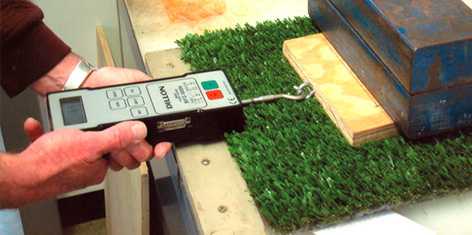
AvTurf is fully tested and proven for safety, performance, longevity and the environment.
Hundreds of quality assurance tests have demonstrated AvTurf will achieve the highest performance standards in terms of airport ground safety in all critical areas.
-
 WIND TUNNEL & BURN TESTS: AvTurf demonstrated superiority in adhesion and lack of flammability
WIND TUNNEL & BURN TESTS: AvTurf demonstrated superiority in adhesion and lack of flammability
-
 JET BLAST: AvTurf does not show signs of movement or uplift from jet blast
JET BLAST: AvTurf does not show signs of movement or uplift from jet blast
-
 DRAINAGE: AvTurf can accommodate high rainfall rates, when placed over a highly permeable layer
DRAINAGE: AvTurf can accommodate high rainfall rates, when placed over a highly permeable layer
-
 LOAD BEARING: AvTurf can support ultra-heavy loads, including large aircraft and emergency response equipment
LOAD BEARING: AvTurf can support ultra-heavy loads, including large aircraft and emergency response equipment
-
 ASTM: Meets the applicable compliance installation requirements
ASTM: Meets the applicable compliance installation requirements

WIND TUNNEL
The FAA examined airside applications of synthetic turf and its resistance to jet blast. The results ensured that synthetic turf would not become dislodged or cause foreign object debris (FOD) damage with daily use. An AvTurf test strip was installed at the blast area of a runway at Chicago Midway Airport (MDW). As documented in the June 2006 "Airside Applications for Synthetic Turf" report, the test successfully showed that the AvTurf strip did not show any signs of movement or uplift in both studies.
A test strip was also installed near a helipad at MDW. This test consisted of having helicopters hover-taxi across the top of the surface at low altitudes. This test also successfully showed that there were no adverse effects of this activity on AvTurf.

BURN
FAA examined several characteristics associated with airside applications of synthetic turf, including flammability field tests, which were performed in full wind conditions at Chicago Midway Airport on October 12, 2000. Plywood construction test boxes were filled with turf samples atop a dry sand base and a rock sub-base. Based on what could be expected as fuel spills, aviation grade Jet-A fuel, vehicle-grade diesel, and vehicle-grade unleaded gasoline were poured over nearly half of the sample surfaces. When ignited, the fibers melted away from the flame, thereby limiting the spread of the flame. Even with the force of a 16-knot wind, the flame did not spread beyond the fuel-soaked fibers.

DRAINAGE
Based on testing conducted in 2003 at the laboratories of the University Of Illinois Urbana-Champaign Center Of Excellence for Airport Technology Affiliates Program, AvTurf synthetic turf is able to accommodate the vertical flow of water at high rainfall rates, when it is placed over a highly permeable layer. The results from three tests conducted at average rainfall intensities of 5.5 inches per hour dramatically showed that there was practically no surface runoff, as the majority of the rainfall passed through the drainage layer beneath the turf. Traces of ponding or surface runoff occurred only when the rainfall intensity rose to 8 inches per hour.
The same type of testing was conducted at an actual installation of AvTurf at Baltimore Washington Thurgood Marshall Airport, where water intensities to simulate rainfall were applied to the synthetic turf. These tests indicated that even after high intensities of rainfall were induced, surface runoff and ponding dissipated immediately as soon as the intensity decreased.

JET BLAST
During the FAA’s examination of the characteristics associated with airside applications of synthetic turf, jet blast resistance was studied. The objective consisted of ensuring that synthetic turf would not become dislodged or cause foreign object debris (FOD) damage with daily use. An AvTurf test strip was installed at the blast area of a runway at Chicago Midway Airport (MDW). As documented in the June 2006 “Airside Applications for Artificial Turf” report, the test successfully showed that the AvTurf strip did not show any signs of movement or uplift
Similarly, a test strip of the synthetic turf was also installed near a helipad at MDW. This test consisted of having helicopters hover-taxi across the top of the surface at low altitudes. This test also successfully showed that there were no adverse effects of this activity on AvTurf.

LOAD BEARING
AvTurf’s Synthetic Grass & Compactable Fill Loading Demonstration to Evaluate Aircraft Arresting Bed Utilization showed that AvTurf’s synthetic grass component consistently maintains the integrity of the base aggregate materials when fill is above 90 percent compaction and support levels of aircraft and airfield equipment in excess of 100,000 pounds are achieved. Conducted at the Advanced Transportation Research and Engineering Laboratory in conjunction with the FAA Center of Excellence for Airport Technology at the University of Illinois, the 2002 study found that “AvTurf and the properties associated with the patented installation process will mirror the integrity of the compactable fill materials utilized in site specific base installations.” This conclusion is demonstrated in all current AvTurf airfield installation

ASTM TESTING
In order to comply with the FAA Advisory Circular 150/5370-15B requirement for various laboratory tests to be completed on artificial turf prior to its installation on an airfield, AvTurf has successfully completed all American Society for Testing and Materials (ASTM) and other laboratory tests outlined in the Advisory Circular. By completing these tests, the AvTurf products are eligible for funding under the Airport Improvement Program (AIP) or Passenger Facility Charge (PFC) Program. Copies of these test results are available upon request.


